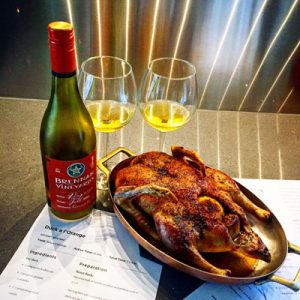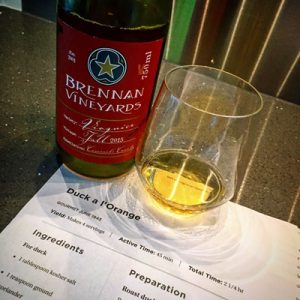Wine a l’Orange: 2015 Brennan Vineyards Cellar Select Viognier
While it is possible to ferment a wine made from orange juice and infuse a wine with the juice of citrus (like Sangria), I hope that you realize that this story is NOT going to be about that kind of wine. However, it IS a story that came about while I was looking for a wine to serve with a favorite dish I make – Duck a l’Orange and thus appeared… my Wine a l’Orange, Voila!
As my story goes, on a recent trip down the Wine Road 290 near Fredericksburg I stopped in at Four Point Cellars for a taste or two or four or six (actually forgot how many) with manager Jesse Barter. When we got to wine three (I think it was), he pulled up a bottle of Brennan Vineyards 2015 Cellar Select Viognier.
I recall that it had an interesting orange-red label. In short order, Jesse proceeded to pour me an ounce and a half of a wine with a noticeable orange color and a bracing kick. For a grape that would normally be considered a “white wine” grape, I thought this a bit odd for Viognier. But, he gave a reassuring glance followed a comment, “This is Brennan Vineyards winemaker Todd Webster’s “orange wine”.
Later, I followed up with Todd Webster, Executive Winemaker at Brennan Vineyards about his orange wine. He said, “I saw an article about skin fermented wine in one of our trade magazines. So I started reading more about was called ‘orange wine’.”
I guess there is a need for a little background here for those not familiar with the term orange wine…
Typically, white wines are made by crushing the grapes and quickly getting the juice off the skins and into a fermenter with little skin contact. All grape skins contain color and tannins (whites and reds), but we mostly bring that into the winemaking equation only when making red wines through extended skin contact with the grape must to impose color and tannin to bring both visual appeal and structure to the wine.
In the making of white wines, this skin contact is usually considered undesirable and some cases a flaw. But, orange wines get their name from the noticeable orange hue that they get from extended contact with grape skins in the winemaking process.
Then, I asked Todd why would someone want to make orange wines in the first place, especially in Texas.
He said, “A common theme in this style of winemaking is that it produces more wine. We get low press yields with Viognier so if there was a way to produce more Viognier with the same amount of grapes, I was all in.”
From here, it was all about the 2015 vintage in Texas that brought about the Todd’s first orange wine and, as far as I know, the first made in this state.
According to Todd, “In 2015, we had an abundance of Viognier; in fact, more than we have even had. So, it was a perfect year to try something new. I contacted our Texas supplier and we talked, and finally came up with a protocol for making our orange wine.”
It turns out that one can leave different varieties of grapes on the skins for different amounts of time. Viognier, in particular, happens to be one variety you don’t want to soak on the skins too long because it is high in phenolics to start with.
Todd said, “So, we decided that we would go for skin contact of a few days and we fermented the wine at a little higher temperature than we normally do for our other whites.”
“I love how the wine turned out, Todd added. “But, serving temperature is key with this wine. If you serve it like a white wine (too cold), it loses all of its greatness. So, it needs to be served at the temperature you would use for a red wine.” I took this a just under normal room temperature – may be 60-65 F.
In my wine and duck a l’orange pairing, I heeded Todd’s advise on service temperature. It appears that skin contact tends to mute the normal floral and stone fruit characteristics of Viognier. The warmer serving temperature tends to bring out more of these nice floral aromatics. Warmer serving also takes a bit of the harsher side of the tannic bite off the wine that you get when the wine is cold. It also brings palate dryness and olfactory characteristics of citrus and note of roasted hazelnuts or walnuts.
The Brennan Vineyards Cellar Select Viognier is a BIG wine yielding much more than your typical white wine mouthfeel. It comes with good dose of dry tannins and alcohol (at 15.4%). It is a wine that perhaps will be best appreciated by red wine drinkers or maybe those used to drinking those good old well-oaked California Chardonnays. This wine really paired well with my very flavorful duck preparation with the orange color and citrus notes from the wine melding with the l’orange sauce. Additionally, with the duck being primarily dark meat, it had the body and flavor to match that offered by the wine. Other pairing ideas are salmon, wild game birds and possibly even farm-raised boar or venison.
— — — — —
Factoid: Orange wines were common in Italy in the 1950s and 1960s mainly in the northeastern regions which were growing white grapes. It gave them another style of wine to make from grapes like Pinot Grigio that like Viognier gain a rose or orange color on their skins when they ripen. Some in Italy refer to this style as “copper wines” or “ramato wines” as the skins of Pinot Grigio give the wine a coppery orange color. Gradually orange wines became a footnote in history as fresh white wines became the dominate style in the marketplace. But, it appears not so for winemaker Todd Webster and Brennan Vineyards who is working to keep the style alive.


